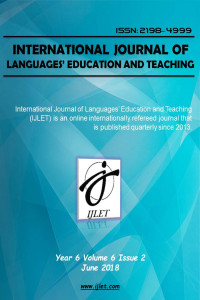Öz
The scientific basis of the Turkish/ language teaching is generally nourished by two fields of science. One of them is linguistics and the other one is semiology. Semiology, in a strict sense, is about the visuals based upon the visual perception. Visual perception is a cognitive activity whereas perception is a process within the visual thinking. Visual thinking is a sensorial way of thinking. It has a high-level function in perceiving and understanding and in being perceived and narrating. The first learning of a child is realized by the visual sense which is developed and used before the verbal skills. For this reason, it can be stated that the human cognition starts with the visual sense. Cognition is a cognitive result that is acquired by a child using the visual sense to develop and use mental capabilities such as looking, acknowledging, and associating. For these reasons, the primary course resources of language teaching are developed on visual and textual relation. In addition, visual reading and visual presentation are types of skills with a continuous increase of its effectiveness, functionality and importance in terms of comprehension and narration in everyday life, in education, in science, in art and almost in all areas of life. Due to the stated effectiveness, functionality and importance, the primary purpose of the study is to attract attention to the fact that the development of the mentioned skill model should be based on theoretical background information in Turkish/Native language teaching from the viewpoint of “even though all teaching is based upon the behavior, the important part is conceptual and theoretical”..In the conclusion part, conceptual/theoretical determinations were associated and integrated with the skill education and recommendations have been presented and interpreted.
Anahtar Kelimeler
language indicator semiology visual perception visual reading/comprehension narration
Kaynakça
- Aksan, D. (1982). Dilbilim Seçkisi, Ankara, TDK
- Akyol,H. (2007). İlköğretimde Türkçe Öğretimi.Görsel Okuma, Ankara, PegemA Yayıncılık
- Barthes, R. (1982). Göstergebilime Bir Yaklaşım, Yazko Çeviri, (Çev.M.Yakın), C.II. (9)
- Başaran, M. (2013). Görsel Okuryazarlığı, Türkçe Öğretimi El Kitabı içinde, Ankara, Pegem Akademi Yayınları,
- Başkan,Ö. (1988). Bildirişim, İstanbul, Altın Kitaplar
- Benveniste, E. (1995). Genel Dilbilim Sorunları. (Çev: Erdim Öztokat). İstanbul, Yapı Kredi Yayınları.
- Busmann,H (2006) . Dictionary of Languge and Linguistics, London, Routledge
- Chomsky, N. (2009). Bilgi Sorunları ve Dil, İstanbul, Bgst Yayınları
- Chomsky, N. (2014). Dilin Mimarisi, İstanbul, Boğaçiçi Üniversitesi Yayınları
Öz
Türkçe/dil eğitimi öğretiminin bilimsel dayanağını genel olarak iki bilim alanı beslemektedir. Bunlardan biri dilbilim, diğeri ise göstergebilimdir. Göstergebilim, dar anlamda, görsel algıya dayalı görselleri konu alır. Görsel algı, bilişsel bir etkinliktir. Algılama ise görsel düşünme ile iç içe bir süreçtir. Görsel düşünme, duyusal bir düşünme biçimidir. Görsel düşünmenin, algılayıp anlama ve algılatıp anlatmada yüksek düzeyde bir işlevi vardır. Çocukta, ilk öğrenmeler, konuşma becerisinden önce gelişen ve kullanılan görme duyusu ile gerçekleşir. Bu nedenle, insanda bilme yetisinin görme duyusu ile başladığı söylenebilir. Bilme, görme duyusunu kullanan çocuğun, bakma, tanıma, ilişkilendirme gibi zihinsel yetilerini geliştirip kullanması ile ulaştığı bir bilişsel sonuçtur. Bu gerekçelerle, dil eğitimi öğretiminin temel ders kaynakları görsel ve metin ilişkisiyle üretilmektedir. Bunun yanında, görsel okuma ve görsel sunu, gündelik yaşamda, eğitim öğretimde, bilimde, sanatta, neredeyse yaşamın her alanında, anlama ve anlatmada, etkililiği, işlevliliği ve önemi sürekli artan, bir beceri türüdür. Belirtilen, etkilik, işlevsellik ve önem nedeniyle, çalışmanın birincil amacı, “tüm öğretim davranışa dayalı olsa da önemli yanı kavramsal ve kuramsaldır” gerçeğinden de hareketle, Türkçe/anadil eğitimi öğretiminde, adıgeçen beceri türünün geliştirilmesinin kuramsal alanbilgisine dayandırılması gerektiğine dikkat çekmektir. Bu amaçla, kavramsal/kuramsal belirlenimler, beceri eğitimi ile ilişkilendirilip, bütünleştirilerek, öneriler geliştirilmiş, yorumlanmıştır.
Anahtar Kelimeler
Anahtar kelime anahtar kelime anahtar kelime anahtar kelime anahtar kelime
Kaynakça
- Aksan, D. (1982). Dilbilim Seçkisi, Ankara, TDK
- Akyol,H. (2007). İlköğretimde Türkçe Öğretimi.Görsel Okuma, Ankara, PegemA Yayıncılık
- Barthes, R. (1982). Göstergebilime Bir Yaklaşım, Yazko Çeviri, (Çev.M.Yakın), C.II. (9)
- Başaran, M. (2013). Görsel Okuryazarlığı, Türkçe Öğretimi El Kitabı içinde, Ankara, Pegem Akademi Yayınları,
- Başkan,Ö. (1988). Bildirişim, İstanbul, Altın Kitaplar
- Benveniste, E. (1995). Genel Dilbilim Sorunları. (Çev: Erdim Öztokat). İstanbul, Yapı Kredi Yayınları.
- Busmann,H (2006) . Dictionary of Languge and Linguistics, London, Routledge
- Chomsky, N. (2009). Bilgi Sorunları ve Dil, İstanbul, Bgst Yayınları
- Chomsky, N. (2014). Dilin Mimarisi, İstanbul, Boğaçiçi Üniversitesi Yayınları
Ayrıntılar
| Birincil Dil | Türkçe |
|---|---|
| Konular | Uygulamalı Dilbilim ve Eğitim Dilbilimi , Türkçe Eğitimi |
| Bölüm | Araştırma Makalesi |
| Yazarlar | |
| Yayımlanma Tarihi | 30 Haziran 2018 |
| Yayımlandığı Sayı | Yıl 2018 Cilt: 6 Sayı: 2 |


